Warning: slight spoilers for Doctor Who episodes that are all 20+ years old
Doctor Who is slowly taking over the world, with one of the biggest fandoms on the internet. And with the promise of both a new showrunner and a new, female, Doctor coming soon, I imagine it’s only going to get bigger.
A lot of you reading this might have been thinking about taking a look yourself. Or maybe you’re fans of Modern Who (Doctors 9-12, with 13 on the way and 8 in a weird gray area) and have just never dived into Classic Who (Doctors 1-7). After all, that’s over thirty years of television to watch. Some of it’s in black and white, all of it is in a big, serialized format with almost nothing but multi-part stories, and the pacing and acting is just very different from modern television. So that’s a big commitment for something that can seem very unfriendly.
Never fear, that’s why I’m here! This is a guide, containing six Classic stories that are what I consider the best for Modern Who fans to use as a jumping in point—the ones that will help you figure out if you like this or not. This list doesn’t feature episodes from every Doctor mind you (the eras for Doctors 1 and 6 are…tricky and not what you want for your first viewing), but instead just some essentials. I compiled them based on connections to the Modern series, importance to the show, overall watchability, and personal preference. I’ll be listing them in chronological order, with the oldest first and the most recent last. But, before we get into that, let’s lay down some ground rules for y’all.
- Don’t worry about the companions. Over the course of the Classic series there were roughly thirty companions, all with their own backstories and character arcs. Of the six stories selected for you here, only one serves as the introduction of a companion, so there’s not going be much background for you. You’re still easing into Classic Who, so for now, just accept that they’re traveling with the Doctor.
- Continuity is wonky. You’re looking at the show’s roots, back when a lot of concepts hadn’t really been ironed out. For example, the Time Lords weren’t introduced until the 2nd Doctor’s final episode, the word regeneration wasn’t used until the 3rd, and the less said about the discrepancies in Dalek backstory, the better. So don’t worry too much, and just accept that things are different than you’re used too.
- Yes, it’s cheap. Doctor Who has rarely enjoyed a big budget, especially in the Classic era. You will see bubble wrap masquerading as advanced technology, Cybermen wearing household scraps, and bad green screens. Just accept the cheesiness, and try to focus on anything else.
We Good? Good.
The War Games (2nd Doctor, 1969)
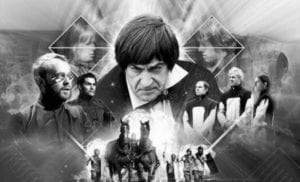
The Doctor and his companions find themselves on a strange planet populated by humans. At first they believe themselves to be in World War 1, based on the technology and fashion they see. However, after passing through a fog bank they encounter Roman soldiers. Another fog bank leads them to the American Civil War. Over time they piece together that a race of aliens has been gathering soldiers from across Earth’s history and putting them through a trial by fire, with the goal being to build an army that can conquer the galaxy. The head of these experiments is a figure known as the War Chief, who carries some secrets that deeply impact the Doctor.
The War Games is important to the series for a number of reasons. It was the first to name the Time Lords, the fiftieth story, the last filmed in black and white, and the final episode for Patrick Troughton, the Second Doctor (aside from three multi Doctor stories). This is the episode that made Doctor Who. The change from William Hartnell to Patrick Troughton was interesting, but could have been written off as a quirk necessitated by an actor’s failing health. Having the Doctor change for a second time? That was a pattern, and the thing that would allow Doctor Who to live on for half a century and counting.
All that being, said, it should be established upfront that this story is ten episodes long, clocking in at roughly four hours, the second longest in the series. That is a big time commitment, I won’t lie. But for the importance it holds in the series’ history, and the excellence of the acting, I have to include it.
Terror of the Autons (3rd Doctor, 1971)
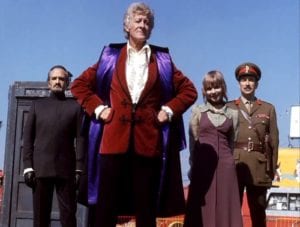
A mysterious male Time Lord lands his TARDIS in a circus and sets about enacting an evil scheme. He steals and reactivates a mysterious alien device, uses hypnotism to take control of a small plastics firm, and starts making evil plastic stuff, like chairs that eat you, plastic flowers that spray sealant over your mouth and nose, and of course, evil dolls. I can see that those of you who have seen Rose are nodding, you know where this is going.
The 3rd Doctor ends up investigating the deaths caused by the chairs and dolls, accompanied by a young woman, Jo Grant, the assistant given to him by UNIT. Oh yeah, if you’ve been wondering about all the jokes about the Doctor working for UNIT and having had a desk at one point, this is where that comes from. Due to budget restrictions and a new set of writers, the 3rd Doctor spent most of his life trapped on Earth, unable to leave the planet and instead going on some very James Bond esque adventures.
Terror of the Autons is important for one very big reason. And no, it’s not introducing the Autons or Jo. The Autons are minor villains and while Jo is great, her introduction doesn’t warrant a spot on this list. No, it’s important because the male Time Lord behind all of this is the Master, making his first appearance. Yeah, this is where he starts. And if you’ve been wondering about Missy’s turn towards the end of her run, there’s a precedent for that. This story ends with the Master and Doctor working together to repel the invasion of earth, the Master realizing that his alien partners will likely turn on him once he’s no longer needed. And when the Master vanishes, the Doctor says he looks forward to seeing him again.
Also, it’s only four parts, so not too long.
The Three Doctors (2nd and 3rd Doctor, 1972-1973)
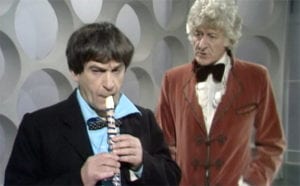
The 3rd Doctor is being hunted by a mysterious blob creature. Unable to harm it himself, he reluctantly calls upon the Time Lords for aid. They’re busy with a black hole draining their power though, and so instead manipulate time to allow the Doctor’s past selves to interact with him. The 2nd immediately arrives and proceeds to bicker with the 3rd for a while. The 1st appears briefly, but is caught in a ‘time eddy’ and so can only briefly speak to them via a screen (William Hartnell was too sick to do more) though he deduces that the blob creature is a ‘time bridge’. The 3rd and Jo step into the blob and are transported to a world made of antimatter, with the 2nd and the Brigadier following close behind.
The problem, it turns out, is Omega, a figure from Time Lord history and one of the three founding members of Time Lord society. Omega was the one who invented time travel, being a stellar engineer. However, one of his experiments went wrong and he was trapped in the antimatter universe. He wants to return, but his time in the antimatter universe has converted him to a being of antimatter and as such he needs a counterpart made of matter to replace him. Hence the blob monster hunting the Doctor. Omega has been driven mad by the centuries of isolation, and threatens to destroy the universe. Both Doctors must work together to stop him and save the universe.
So yeah, quite the big story! Another four parter though, it was just released in the penultimate week of December 1972, hence the two years on the header, don’t worry. This was the first multi Doctor crossover, with two more in the Classic series (The Four Doctors and The Two Doctors) and one in the Modern series so far (The Day of the Doctor) done in celebration of the show’s tenth anniversary. I picked it over The Four Doctors because while that story has more Doctors in it, this one has a better story in my opinion. Certainly better than The Two Doctors, which is fun but…iffy.
Genesis of the Daleks (4th Doctor, 1975)
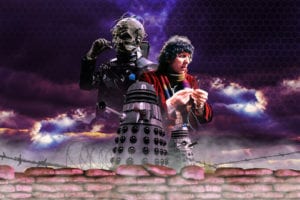
The Doctor and companions are waylaid on their attempt to return to earth, finding themselves on a strange, foggy and rocky planet. The Doctor speaks to a black robed Time Lord, who reveals himself a part of the Time Lord’s black ops division, and declares that they have a mission for the Doctor. He and his companions are now on Skaro, homeworld of the Daleks, thousands of years in the past. The mission? Either divert the Daleks into taking on a more peaceful form, or stop them from existing. But as the Doctor prepares to destroy them in the cradle, to keep them from existing, he asks one question: “Do I have the right?”
For anyone who knows the Classic series, the inclusion of this story comes as no surprise. It is a classic, and often considered one of the best, if not the best, in the show’s history. It dives into aspects of the lore that hadn’t been touched before, introduced a popular villain with Davros, and dived into deep ethical issues that the show hadn’t touched in the past. It has ties to the Modern series as well, and not just in the form of Davros knowing who Sarah Jane is in Journey’s End. Russell T. Davies declared the story to be the opening shot of the Last Great Time War which…is honestly brilliant. And I’m not a big Davies fan, so you know I’m sincere when I say that.
So, for its importance to canon, its overall quality of writing and especially acting, and for diving into interesting questions of morality, I highly recommend this story. It’s six parts, but worth every second of it.
Earthshock (5th Doctor, 1982)
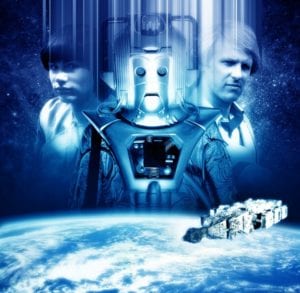
The Doctor and his Companions have wound up in Earth’s future, and wind up embroiled in a plot by the Cybermen to attack a peace conference and assassinate the visiting dignitaries. And…that’s all the summary I’m going to give you folks. Sorry, I know that’s not much, but this story ends with a rather dark but important twist that I don’t want to give away, and telling you more runs the risk of doing just that. If you haven’t seen this story yet, and have any interest in the Classic series, I urge you to not look up the ending, and just go watch it. It’s four twenty five minute episodes, and worth it, I promise you.
Here’s what else I can tell you about the story in general. It isn’t necessarily the Classic Cybermen’s finest moment, but it is the story that represents them the best, a sort of averaging out of the Cybermen stories of the old series. And yes, I do know that they look plastic and not metal, remember rule number three and let’s move on! It also touches on an idea and theme that was only rarely used in the Classic series, and still has not been fully utilized by the Modern series. And it really is one of the best Peter Davison stories, and a good way for 10th Doctor fans to learn exactly why he is David Tennant’s Doctor. That’s all I’m going to say though, sorry to be a tease!
Remembrance of the Daleks (7th Doctor, 1988)
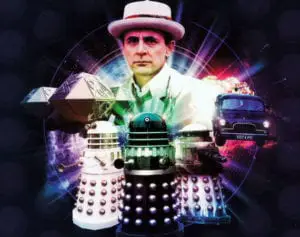
Coming out in the twenty fifth anniversary year, Remembrance of the Daleks returns back to the roots of the series. It takes place in the UK in 1963, mere days after the 1st Doctor left in the very first aired episode of Doctor Who. It reveals the reason the Doctor arrived on earth in the first place, hiding an ancient Time Lord artifact, as the 7th Doctor works to keep it out of the hands of the Daleks, who have split into factions and are fighting each other and attempting to access the artifact in hopes of getting it for themselves.
Remembrance is important for a number of reasons, and not just for its ties to the series’ origins. It’s the last appearance of Davros or the Daleks until 2005, and an excellent send off to boot, even if it wasn’t meant to be such. It features the 7th Doctor at his peak 7th Doctor-ness, a consummate chess-master with layers of plans and a mentor to his companion. Speaking of, the 7th Doctor’s companion is Ace, and she’s amazing. This story features her most famous moment, in which she destroys a Dalek with a heavily modified baseball bat because it called her small.
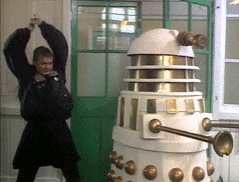
And I’m not going to lie, this is my absolute favorite story of the entire series, Classic or Modern. Not just for the scene in the gif, but for the quality of the writing and the acting, the sheer excellence on display here. The 7th Doctor is my favorite Classic Doctor (second overall), Ace is my favorite companion period, and this is the both of them at their peak. Watch it!
So, there you have it. For any Modern Who fans, I hope this was helpful. These aren’t all necessarily the best episodes of the Classic series, but these should serve to give you a good place to start! Hope it helps!

